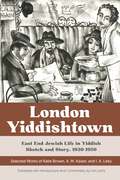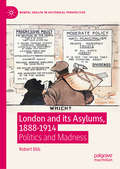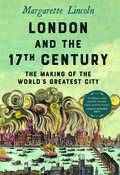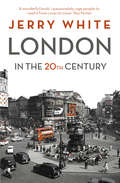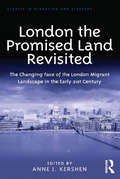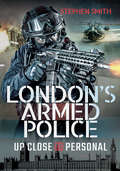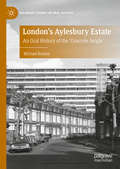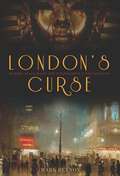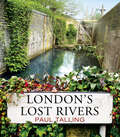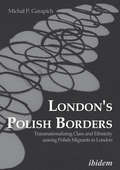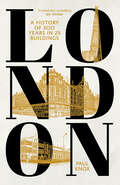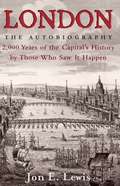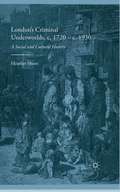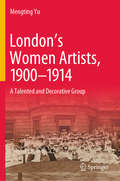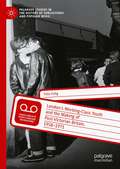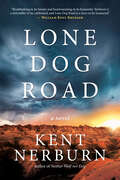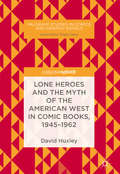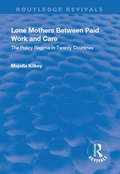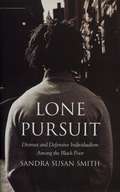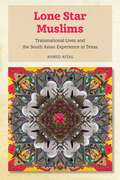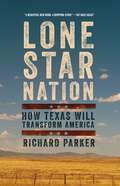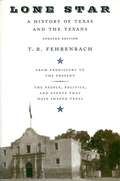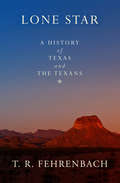- Table View
- List View
London Yiddishtown: East End Jewish Life in Yiddish Sketch and Story, 1930–1950: Selected Works of Katie Brown, A. M. Kaizer, and I. A. Lisky
by Katie Brown I. A. Lisky A. M. KaizerIn London Yiddishtown: East End Jewish Life in Yiddish Sketch and Story, 1930–1950, Vivi Lachs presents a selection of previously un-translated short stories and sketches by Katie Brown, A. M. Kaizer, and I. A. Lisky, for the general reader and academic alike. These intriguing and entertaining tales build a picture of a lively East-End community of the 30s and 40s struggling with political, religious, and community concerns. Lachs includes a new history of the Yiddish literary milieu and biographies of the writers, with information gleaned from articles, reviews, and obituaries published in London’s Yiddish daily newspapers and periodicals. Lisky’s impassioned stories concern the East End’s clashing ideologies of communism, Zionism, fascism, and Jewish class difference. He shows anti-fascist activism, political debate in a kosher café, East-End extras on a film set, and a hunger march by the unemployed. Kaizer’s witty and satirical tales explore philanthropy, upward mobility, synagogue politics, and competition between Zionist organizations. They expose the character and foibles of the community and make fun of foolish and hypocritical behavior. Brown’s often hilarious sketches address episodes of daily life, which highlight family shenanigans and generational misunderstandings, and point out how the different attachments to Jewish identity of the immigrant generation and their children created unresolvable fractures. Each section begins with a biography of the writer, before launching into the translated stories with contextual notes. London Yiddishtown offers a significant addition to the literature about London, about the East End, about Jewish history, and about Yiddish. The East End has parallels with New York’s Lower East Side, yet London’s comparatively small enclave, and the particular experience of London in the 1930s and the bombing of the East End during the Blitz make this history unique. It is a captivating read that will entice literary and history buffs of all backgrounds. A Yiddish Book Center Translation.
London and its Asylums, 1888-1914: Politics and Madness (Mental Health in Historical Perspective)
by Robert EllisThis book explores the impact that politics had on the management of mental health care at the turn of the nineteenth and twentieth centuries. 1888 and the introduction of the Local Government Act marked a turning point in which democratically elected bodies became responsible for the management of madness for the first time. With its focus on London in the period leading up to the First World War, it offers a new way to look at institutions and to consider their connections to wider issues that were facing the capital and the nation. The chapters that follow place London at the heart of international networks and debates relating to finance, welfare, architecture, scientific and medical initiatives, and the developing responses to immigrant populations. Overall, it shines a light on the relationships between mental health policies and other ideological priorities.
London and the Seventeenth Century: The Making of the World's Greatest City
by Margarette LincolnThe first comprehensive history of seventeenth-century London, told through the lives of those who experienced it The Gunpowder Plot, the Civil Wars, Charles I&’s execution, the Plague, the Great Fire, the Restoration, and then the Glorious Revolution: the seventeenth century was one of the most momentous times in the history of Britain, and Londoners took center stage. In this fascinating account, Margarette Lincoln charts the impact of national events on an ever-growing citizenry with its love of pageantry, spectacle, and enterprise. Lincoln looks at how religious, political, and financial tensions were fomented by commercial ambition, expansion, and hardship. In addition to events at court and parliament, she evokes the remarkable figures of the period, including Shakespeare, Bacon, Pepys, and Newton, and draws on diaries, letters, and wills to trace the untold stories of ordinary Londoners. Through their eyes, we see how the nation emerged from a turbulent century poised to become a great maritime power with London at its heart—the greatest city of its time.
London at War, 1939-1945
by Philip ZieglerIn 1939, London was not merely the greatest city in the world, it was the most tempting and vulnerable target for aerial attack. For six years it was in the front line of the free world’s battle against Fascism. It endured the horrors of the blitz of 1940 and 1941, the V1s, the V2s. Other cities suffered more intensely; no other city was so consistently under attack for so long a time. This is the story of London at war from 1939 to 1945, or perhaps of Londoners at war--for Philip Ziegler, best known as a biographer, is above all fascinated by the people who found their lives so suddenly and violently transformed: the querulous, tiresome, yet strangely gallant housewife from West Hampstead; the turbulent, left-wing, retired schoolmaster from Walthamstow, always standing up to the authorities; the odiously snobbish middle-class woman from Kensington, sneering at the 'scum' who took shelter in the Underground; the typist from Fulham; the plumber from Woolwich. It was their war every bit as much as it was Churchill’s or the King’s, and this is their story. Through a wealth of interviews and unpublished letters and diaries, as well as innumerable books and newspapers, the author has built up a dazzling portrait of an entire population under siege. There were cowards, there were criminals, there were incompetents, but what emerges from these pages is above all a record, in story after story, of astonishing patience, dignity and humour. 'I hope,' Ziegler writes, 'we will never have to endure again what they went through between 1939 and 1945. I hope, if we did, that we would conduct ourselves as well.'
London in the Twentieth Century: A City and Its People
by Jerry WhiteJerry White's London in the Twentieth Century, Winner of the Wolfson Prize, is a masterful account of the city’s most tumultuous century by its leading expert.In 1901 no other city matched London in size, wealth and grandeur. Yet it was also a city where poverty and disease were rife. For its inhabitants, such contradictions and diversity were the defining experience of the next century of dazzling change.In the worlds of work and popular culture, politics and crime, through war, immigration and sexual revolution, Jerry White’s richly detailed and captivating history shows how the city shaped their lives and how it in turn was shaped by them.
London the Promised Land Revisited: The Changing Face of the London Migrant Landscape in the Early 21st Century (Studies in Migration and Diaspora)
by Anne J. KershenSome two decades since the publication of London the Promised Land?, which charted and investigated the successes and failures of the migrant experience in London over a period of three hundred years, this book re-examines the migrant landscape in London. While remaining a beacon for immigrants, the migrant face of the city has changed rapidly and dramatically from one which was heavily populated by semi-skilled and unskilled post-colonial incomers, to one which now embraces the EU Accession Countries, refugees from the Middle East and Africa, oligarchs from Russia, the new wealthy from China, economic migrants from Latin America and Ireland, and still, post-colonial immigrants - at the same time witnessing the exodus ’home’ of incomers, or their descendants, who now see opportunities where there were none before. The contributors, all leading academics and practitioners in their diverse fields, examine changes to the migrant landscape of contemporary London at the micro, meso and macro levels. London the Promised Land Revisited thus explores a range of experiences in the capital, including the presence and treatment of illness amongst migrants, the phenomenon of migrant ’invisibility’ and asylum, the migrant marketplace and ethnic ’clustering’, and interaction with local and national government - across a variety of migrant groups, both ’new’ and ’old’. As such, this book will appeal to scholars across the social sciences with interest in migration, migrant experiences and the contemporary ’global’ city.
London's Armed Police: Up Close and Personal
by Stephen SmithAn insider&’s account of an elite unit fighting crime and terror on the streets of London—includes hundreds of photos. In this book, veteran firearms officer Stephen Smith goes behind the scenes of the Metropolitan Police&’s Specialist Firearms Unit, CO19—covering a wide range of events in recent history, from the controversial shootings of Azelle Rodney in 2005 and Mark Duggan in 2011 to the terrorist attacks on Westminster, London Bridge and Borough Market, as well as stories from decades past. Through his unique access to CO19, Smith has managed to put together hundreds of detailed photographs, both historical and contemporary, along with text that goes a long way to explain why it is necessary to have such an elite firearms unit on standby 24/7 in London. This comprehensive volume will bring you up-to date with the training, operations, equipment, and mindset of these courageous individuals who put their lives on the line on a daily basis to keep London safe.
London's Aylesbury Estate: An Oral History of the 'Concrete Jungle' (Palgrave Studies in Oral History)
by Michael RomynThis book looks beyond the Aylesbury’s public face by examining its rise and fall from the perspective of those who knew it, based largely on the oral testimony and memoir of residents and former residents, youth and community workers, borough Councillors, officials, police officers and architects. What emerges is not a simple story of definitive failures, but one of texture and complexity, struggle and accord, family and friends, and of rapidly changing circumstances. The study spans the years 1967 to 2010 – from the estate’s ambitious inception until the first of its blocks were pulled down. It is a period rarely dealt with by historians of council housing, who have typically confined themselves to the years before or after the 1979 watershed. As such, it demonstrates how shifts in housing policy, and broader political, economic and social developments, came to bear on a working-class community – for good and, more especially, for ill.
London's Curse: Murder, Black Magic and Tutankhamun in the 1920s West End
by Mark BeynonThroughout the 1920s and 1930s, London was gripped by the supposed curse of Tutankhamun, whose tomb in the Luxor sands was uncovered in February 1923 by the British archaeologist Howard Carter. The site was plundered, and over the next few years more than twenty of those involved in the exhumation or in handling the contents of the tomb perished in strange and often terrifying circumstances, prompting the myth of the 'Curse of Tutankhamun'. Nowhere - particularly London's West End - appeared to be safe for those who had provoked the ire of the Egyptian death gods. A blend of meticulous research and educated conjecture, historian and screenwriter Mark Beynon turns armchair detective as he uncovers a wealth of hitherto unpublished material that lays bare the truth behind these fatalities. Could 'London's Curse' be attributed to the work of a macabre mastermind? It soon becomes apparent that these deaths were not only linked by the ominous presence of Tutankhamun himself, but also by a murderer hell-bent on retribution and dubbed by the press as 'The Wickedest Man in the World'.
London's Lost Rivers: a beautifully illustrated guide to London's secret rivers
by Paul TallingPacked with surprising and fascinating information, London's Lost Rivers uncovers a very different side to London - showing how waterways shaped our principal city and exploring the legacy they leave today. With individual maps to show the course of each river and over 100 colour photographs, it's essential browsing for any Londoner and the perfect gift for anyone who loves exploring the past...'An amazing book' -- BBC Radio London'Talling's highly visual, fact-packed, waffle-free account is the freshest take we've yet seen. A must-buy for anyone who enjoys the "hidden" side of London -- Londonist'A fascinating and stylish guide to exploring the capital's forgotten brooks, waterways, canals and ditches ... it's a terrific book' - Walk'Pocket-sized, beautifully designed, illustrated and informative - in short a joy to read, handle and use' -- ***** Reader review'Delightful, informative and beautifully produced' -- ***** Reader review'A small gem. A really great book. I can't put it down' -- ***** Reader review'Fascinating from start to finish' -- ***** Reader review************************************************************************************************From the sources of the Fleet in Hampstead's ponds to the mouth of the Effra in Vauxhall, via the meander of the Westbourne through 'Knight's Bridge' and the Tyburn's curve along Marylebone Lane, London's Lost Rivers unearths the hidden waterways that flow beneath the streets of the capital. Paul Talling investigates how these rivers shaped the city - forming borough boundaries and transport networks, fashionable spas and stagnant slums - and how they all eventually gave way to railways, roads and sewers. Armed with his camera, he traces their routes and reveals their often overlooked remains: riverside pubs on the Old Kent Road, healing wells in King's Cross, 'stink pipes' in Hammersmith and gurgling gutters on streets across the city. Packed with maps and over 100 colour photographs, London's Lost Rivers uncovers the watery history of the city's most famous sights, bringing to life the very different London that lies beneath our feet.
London's Polish Borders: Transnationalizing Class and Ethnicity among Polish Migrants in London
by Michal P. GarapichThe figure of the Polish plumber or builder has long been a well-established icon of the British national imagination, uncovering the UK's collective unease with immigration from Central and Eastern Europe. But despite the powerful impact the UK's second largest language group has had on their host country's culture and politics, very little is known about its members.This painstakingly researched book offers a broad perspective on Polish migrants in the UK, taking into account discursive actions, policies, family connections, transnational networks, and political engagement of the diaspora. Born out of a decade of ethnographic studies among various communities of Polish nationals living in London, Michal P. Garapich documents the changes affecting both Polish migrants and British society, offering insight into the inner tensions and struggles within what is often assumed to be a uniform and homogeneous category. From Polish financial sector workers to the Polish homeless population, this groundbreaking book provides a street-level account of cultural and social determinants of Polish migrants as they continually rework their relation to class and ethnicity.
London: A History of 300 Years in 25 Buildings
by Paul KnoxA lively new history of London told through twenty-five buildings, from iconic Georgian townhouses to the Shard A walk along any London street takes you past a wealth of seemingly ordinary buildings: an Edwardian church, modernist postwar council housing, stuccoed Italianate terraces, a Bauhaus-inspired library. But these buildings are not just functional. They are evidence of London&’s rich and diverse history and have shaped people&’s experiences, identities, and relationships. In this engaging study, Paul L. Knox traces the history of London from the Georgian era to the present day through twenty-five surviving buildings. Knox explores where people lived and worked, from grand Regency squares to Victorian workshops, and highlights the impact of migration, gentrification, and inequality. We see famous buildings, like Harrods and Abbey Road Studios, and everyday places like Rochelle Street School and Thamesmead. Each historical period has introduced new buildings, and old ones have been repurposed. As Knox shows, it is the living history of these buildings that makes up the vibrant, but exceptionally unequal, city of today.
London: the Autobiography
by Jon E. LewisIn London: The Autobiography the life of the capital is told, for the first time, by those who made it and saw it at first hand. From Roman times to the 21st century, Londoners and visitors to the city have recounted the extraordinary events, everyday life and character of this unique and influential city - from politics, culture, sport, religion, and reportage. This book brings to vivid life the human trial of the capital including invasions by the Vikings, the brutal execution of Sir Thomas More, the sight of a whale swimming up the Thames and the rebuilding of St Paul's by Sir Christopher Wren, as well as the everyday life of the city. Includes contributions from George Orwell, Martin Amis, Dr Johnson, Karl Marx, Winston Churchill, Fyodor Dostoyevsky, Virginia Woolfe, George Melly, Tacitus, Samuel Pepys and many others.Packed with personality and character, this book is a must-buy for anyone interested in London as well as a wonderful story of the city at the heart of the nation.Praise for Jon E Lewis:'A triumph' Saul David, author of Victoria's Army'Harrowing, funny and often unbelievable book.' Daily Express[A] compelling tommy's eye view of war from Agincourt to Iraq' Daily Telegraph
London’s Criminal Underworlds, c. 1720–c. 1930
by Heather ShoreThis book offers an original and exciting analysis of the concept of the criminal underworld. Print culture, policing and law enforcement, criminal networks, space and territory are explored here through a series of case studies taken from the eighteenth, nineteenth and twentieth centuries.
London’s Polish Borders: Transnationalizing Class and Ethnicity Among Polish Migrants in London
by Michał GarapichThe figure of the Polish plumber or builder has long been a well-established icon of the British national imagination, uncovering the UK's collective unease with immigration from Central and Eastern Europe. But despite the powerful impact the UK's second largest language group has had on their host country's culture and politics, very little is known about its members.This painstakingly researched book offers a broad perspective on Polish migrants in the UK, taking into account discursive actions, policies, family connections, transnational networks, and political engagement of the diaspora. Born out of a decade of ethnographic studies among various communities of Polish nationals living in London, Michal P. Garapich documents the changes affecting both Polish migrants and British society, offering insight into the inner tensions and struggles within what is often assumed to be a uniform and homogeneous category. From Polish financial sector workers to the Polish homeless population, this groundbreaking book provides a street-level account of cultural and social determinants of Polish migrants as they continually rework their relation to class and ethnicity.
London’s Women Artists, 1900-1914: A Talented and Decorative Group
by Mengting YuDrawing on untapped archives, as well as aggregating a wide range of existing published sources, this book recalibrates the understanding of women artists’ roles, outputs and receptions in London during what was indubitably a vibrant and innovative period in the history of British art, and in which the work of their male contemporaries is so well understood. The book takes its starting point from Alicia Foster’s article “Gwen John’s Self-Portrait: Art, Identity and Women Students at the Slade School,” published in 2000, where the expression “a talented and decorative group” was coined to describe common attitudes towards women artists in the late 19th and early 20th century London. This pejorative attribution strongly implied a status less significant to that of their male counterparts. The author challenges this statement's basic tenet by casting a wide net in examining women’s art education from the Slade School of Fine Art, through to the role of its graduates within a selection of London’s exhibition groups, societies and publications. This book also reconstructs ‘from scratch’ the role of the Women’s International Art Club (WIAC), hitherto entirely overlooked in art historical studies of the era. This book will be of interest to students and researchers in art and cultural history, gender studies,and in sociological studies of pre-War World War Britain.
London’s Working-Class Youth and the Making of Post-Victorian Britain, 1958–1971 (Palgrave Studies in the History of Subcultures and Popular Music)
by Felix FuhgThis book examines the emergence of modern working-class youth culture through the perspective of an urban history of post-war Britain, with a particular focus on the influence of young people and their culture on Britain’s self-image as a country emerging from the constraints of its post-Victorian, imperial past.Each section of the book – Society, City, Pop, and Space – considers in detail the ways in which working-class youth culture corresponded with a fast-changing metropolitan and urban society in the years following the decline of the British Empire.Was teenage culture rooted in the urban experience and the transformation of working-class neighbourhoods? Did youth subcultures emerge simply as a reaction to Britain's changing racial demographic? To what extent did leisure venues and institutions function as laboratories for a developing British pop culture, which ultimately helped Britain re-establish its prominence on the world stage?These questions and more are answered in this book.
Lone Dog Road: A Novel
by Kent NerburnA tale of compassion and redemption from an award-winning author whose writing Louise Erdrich has praised as “storytelling with a greatness of heart” During the drought-stricken summer of 1950, two Lakota boys, ages eleven and six, huddle in a boxcar hurtling through the prairie night as they run from a government agent sent to take the younger boy to an Indian boarding school. But what begins as a pursuit soon becomes a complex drama of intersecting lives as the boys make their way across the vast Dakota plains to the pipestone quarries of western Minnesota to replace their great-grandfather’s channunpa, or sacred pipe, that was broken by the agent. Alive with a rich tapestry of characters the boys meet along their journey, this riveting story is at once an exploration of the hidden corners of the human heart and a moving study of the way the land shapes the people who live, love, dream, and die upon it. Sprawling yet intimate, Lone Dog Road is destined to take its place in the grand tradition of great American road novels.
Lone Heroes and the Myth of the American West in Comic Books, 1945-1962 (Palgrave Studies in Comics and Graphic Novels)
by David HuxleyThis book examines the role of comics in the perpetuation of the myth of the American West. In particular, it looks at the ways in which lone central characters, and their acts of violence, are posited as heroic. In doing so, the book raises questions both about the role of women in a supposedly male space, in addition to the portrayal of Native Americans within the context of this violence. Various adaptations of historical figures, such as Buffalo Bill and Billy the Kid, as well as film and television stars such as The Lone Ranger and Dale Evans are examined in detail. Although concentrating on American comics, examples both from Britain and France are also analyzed.
Lone Mothers Between Paid Work and Care: The Policy Regime in Twenty Countries (Routledge Revivals)
by Majella KilkeyThis title was first published in 2000. This is a study which compares and contrasts how lone mothers' relationships to paid work and care-giving are constructed across 20 countries, and with what outcomes for lone mothers' levels of economic well-being. In doing so, the book explores from an international perspective, the implications of the re-orientation of lone mothers' citizenship within the UK policy field from that of care-giver to paid worker. The volume engages with feminist comparative social policy literature concerned with specifying a construction of citizenship appropriate to capturing international variations in women's social rights. By incorporating social rights attached to paid work and care, as well as those which enable lone mothers to move between sequential periods of paid work and care-giving across the child-rearing cycle, the study makes a significant contribution to the literature.
Lone Pursuit: Distrust and Defensive Individualism Among the Black Poor
by Sandra Susan SmithUnemployment among black Americans is twice that of whites. Myriad theories have been put forward to explain the persistent employment gap between blacks and whites in the U.S. Structural theorists point to factors such as employer discrimination and the decline of urban manufacturing. Other researchers argue that African-American residents living in urban neighborhoods of concentrated poverty lack social networks that can connect them to employers. Still others believe that African-American culture fosters attitudes of defeatism and resistance to work. In Lone Pursuit, sociologist Sandra Susan Smith cuts through this thicket of competing explanations to examine the actual process of job searching in depth. Lone Pursuit reveals that unemployed African Americans living in the inner city are being let down by jobholding peers and government agencies who could help them find work, but choose not to. Lone Pursuit is a pioneering ethnographic study of the experiences of low-skilled, black urban residents in Michigan as both jobseekers and jobholders. Smith surveyed 105 African-American men and women between the ages of 20 and 40, each of whom had no more than a high school diploma. She finds that mutual distrust thwarts cooperation between jobseekers and jobholders. Jobseekers do not lack social capital per se, but are often unable to make use of the network ties they have. Most jobholders express reluctance about referring their friends and relatives for jobs, fearful of jeopardizing their own reputations with employers. Rather than finding a culture of dependency, Smith discovered that her underprivileged subjects engage in a discourse of individualism. To justify denying assistance to their friends and relatives, jobholders characterize their unemployed peers as lacking in motivation and stress the importance of individual responsibility. As a result, many jobseekers, wary of being demeaned for their needy condition, hesitate to seek referrals from their peers. In a low-skill labor market where employers rely heavily on personal referrals, this go-it-alone approach is profoundly self-defeating. In her observations of a state job center, Smith finds similar distrust and non-cooperation between jobseekers and center staff members, who assume that young black men are unwilling to make an effort to find work. As private contractors hired by the state, the job center also seeks to meet performance quotas by screening out the riskiest prospects—black male and female jobseekers who face the biggest obstacles to employment and thus need the most help. The problem of chronic black joblessness has resisted both the concerted efforts of policymakers and the proliferation of theories offered by researchers. By examining the roots of the African-American unemployment crisis from the vantage point of the everyday job-searching experiences of the urban poor, Lone Pursuit provides a novel answer to this decades-old puzzle.
Lone Star Muslims: Transnational Lives and the South Asian Experience in Texas
by Ahmed AfzalLone Star Muslims offers an engaging and insightful look at contemporary Muslim American life in Texas. It illuminates the dynamics of the Pakistani Muslim community in Houston, a city with one of the largest Muslim populations in the south and southwestern United States. Drawing on interviews and participant observation at radio stations, festivals, and ethnic businesses, the volume explores everyday Muslim lives at the intersection of race, class, profession, gender, sexuality, and religious sectarian affiliation to demonstrate the complexity of the South Asian experience.Importantly, the volume incorporates narratives of gay Muslim American men of Pakistani descent, countering the presumed heteronormativity evident in most of the social science scholarship on Muslim Americans and revealing deeply felt affiliations to Islam through ritual and practice. It also includes narratives of members of the highly skilled Shia Ismaili Muslim labor force employed in corporate America, of Pakistani ethnic entrepreneurs, the working class and the working poor employed in Pakistani ethnic businesses, of community activists, and of radio program hosts. Decentering dominant framings that flatten understandings of transnational Islam and Muslim Americans, such as “terrorist” on the one hand, and “model minority” on the other, Lone Star Muslims offers a glimpse into a variety of lived experiences. It shows how specificities of class, Islamic sectarian affiliation, citizenship status, gender, and sexuality shape transnational identities and mediate racism, marginalities, and abjection.
Lone Star Nation: How Texas Will Transform America
by Richard ParkerA provocative and eye-opening look at the most explosive and controversial state in America, where everything is bigger, bolder--and shaping our nation's future in surprising ways To most Americans, Texas has been that love-it-or-hate it slice of the country that has sparked controversy, bred presidents, and fomented turmoil from the American Civil War to George W. Bush. But that Texas is changing--and it will change America itself. Richard Parker takes the reader on a tour across today's booming Texas, an evolving landscape that is densely urban, overwhelmingly Hispanic, exceedingly powerful in the global economy, and increasingly liberal. This Texas will have to ensure upward mobility, reinvigorate democratic rights, and confront climate change--just to continue its historic economic boom. This is not the Texas of George W. Bush or Rick Perry. Instead, this is a Texas that will remake the American experience in the twenty-first century--as California did in the twentieth--with surprising economic, political, and social consequences. Along the way, Parker analyzes the powerful, interviews the insightful, and tells the story of everyday people because, after all, one in ten Americans in this century will call Texas something else: Home.
Lone Star: A History of Texas and the Texans
by T. R. FehrenbachHere is an up-to-the-moment history of the Lone Star state, together with an insider's look at the people, politics, and events that have shaped Texas from the very beginning. Never before has the story been told with more vitality and immediacy. Fehrenbach re-creates the Texas saga from prehistory, to the Spanish and French invasions, to the heyday of the cotton and cattle empires. He dramatically describes the emergence of Texas as a republic, the vote for secession before the Civil War, and the state's readmission to the Union after the War. In the twentieth century oil would emerge as an important economic resource, and the state would experience significant social change. But Texas would remain unmistakably Texas, because Texans "have been made different by the crucible of history; they think and act in different ways, according to the history that shaped their hearts and minds." This is the updated 2000 edition.
Lone Star: A History of Texas and the Texans
by T. R. FehrenbachThe definitive account of the incomparable Lone Star state by the author of Fire & Blood: A History of Mexico. T. R. Fehrenbach is a native Texan, military historian and the author of several important books about the region, but none as significant as this work, arguably the best single volume about Texas ever published. His account of America's most turbulent state offers a view that only an insider could capture. From the native tribes who lived there to the Spanish and French soldiers who wrested the territory for themselves, then to the dramatic ascension of the republic of Texas and the saga of the Civil War years. Fehrenbach describes the changes that disturbed the state as it forged its unique character. Most compelling is the one quality that would remain forever unchanged through centuries of upheaval: the courage of the men and women who struggled to realize their dreams in The Lone Star State.
